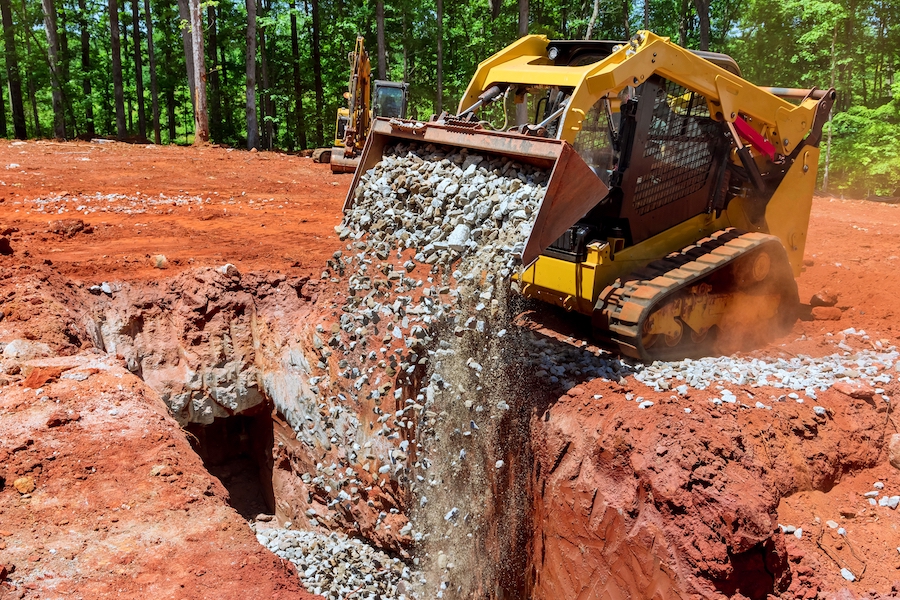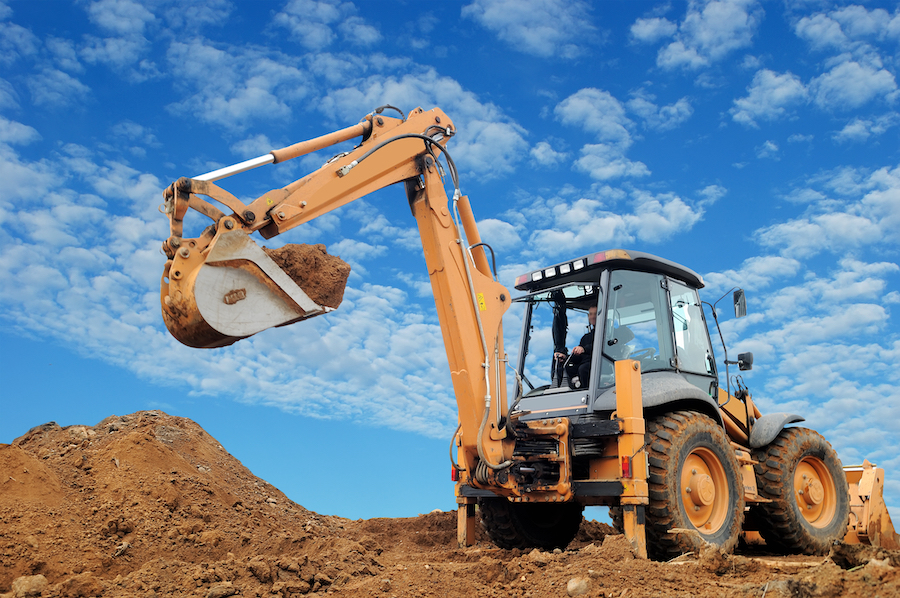
View the complete article here.
Loaders are essential in a wide range of construction projects for their robust design and functional versatility. They are designed to handle tasks ranging from heavy lifting and material transportation on construction sites to agricultural operations like moving hay bales. This guide will explore the diverse purposes of loaders, their types, and how to select the right one for your needs—ensuring efficiency and safety in any project.
Purposes of Loaders
Loaders, with their robust design and front-mounted buckets, are indispensable machines across multiple sectors.
Material Handling and Transportation on Construction Sites
Playing a pivotal role in material handling, loaders are used to move large quantities of building materials—such as soil, sand, and gravel—from one location to another efficiently. Loaders are equipped to handle the rugged terrain of construction sites and can be used to fill trenches, assist in building roads, and prepare the site for various phases of the construction process. Their ability to transport substantial loads quickly makes them a staple in minimizing manual labor and expediting project timelines.
Loading of Materials into Trucks, Hoppers, or Conveyor Belts
Loaders are also essential when it comes to loading materials into other vehicles or processing equipment. They can lift and pour materials into dump trucks for transport, feed raw materials into hoppers for batching in concrete operations, or supply conveyor belts for processing or packaging. The versatility of their buckets or attachments allows for precision in loading, ensuring that materials are handled safely and efficiently without wastage.
Landscaping and Ground Preparation Tasks
In landscaping, loaders are multi-faceted workhorses. They can grade and level ground, preparing it for sod laying or gardening. They also shift large volumes of mulch, soil, or compost—and assist in the creation of terrains such as hills or leveling areas for water features. Compact loaders, in particular, are favored for their maneuverability and minimal ground disturbance—making them perfect for residential and commercial landscaping projects.
Snow Removal and Handling of Other Weather-Related Debris
When winter storms hit, loaders are transformed into snow removal powerhouses. Equipped with specialized attachments like snow plows or blowers—they clear parking lots, roads, and pathways. Their robust engines and traction make them ideal for such conditions, where they can also be used to move fallen trees or debris after weather-related events—aiding in rapid clean-up and recovery efforts.
Agricultural Tasks Such as Moving Hay Bales or Feed
In agriculture, loaders are invaluable for their ability to perform a variety of tasks. They move large hay bales with ease, transport animal feed across farms, and assist in the filling of silos. The loaders’ gentle handling is essential when dealing with delicate materials like seed or grain. With specific attachments, they can also become integral during harvest time—helping to move produce without damage.
Types of Loaders
Loaders are versatile and essential in various industries because of their ability to handle different tasks and operate on diverse terrains.
Wheel Loaders
Wheel loaders are known for their substantial carrying capacity and swift operational speed. Their large wheeled design and articulated steering make them suitable for a broad range of terrains, from the smooth concrete of warehouses to the uneven ground of a construction site. Wheel loaders can be equipped with various attachments, further enhancing their versatility—allowing them to perform tasks such as digging, lifting, and dumping with remarkable efficiency.
Skid Steer Loaders
Skid steer loaders are renowned for their agility and the ability to turn within their own footprint. Their compact size is a significant advantage, enabling them to operate in confined spaces that larger machines cannot access. Despite their smaller stature, skid steers offer robust power and are ideal for a wide array of tasks—including site clean-up, material spreading, and excavation. Their versatility is amplified by a vast selection of attachments, from augers to forks, making them indispensable on a construction site.
Backhoe Loaders
Backhoe loaders combine the digging power of an excavator with the lifting and loading capabilities of a loader. This dual functionality makes them extremely versatile for tasks such as trenching for pipes, backfilling excavations, and moving earth. Their distinctive feature is the two-part articulated arm, which can be outfitted with various attachments for different tasks—making backhoe loaders a popular choice for jobs that require both excavation and material handling.
Compact Track Loaders
Compact track loaders excel in conditions that would challenge other machines—such as soft, muddy, or snowy terrains. The tracks provide increased stability and weight distribution, reducing ground pressure and preventing the machine from sinking into soft soil. This makes them particularly useful for landscaping, grading, and site preparation work in sensitive areas where minimal ground disturbance is desired.
Front-End Loaders
Front-end loaders are typically mounted on tractors and are extensively used in agriculture for their ability to perform tasks such as moving hay bales, loading manure, and handling bulk materials. Their design allows for good visibility and the ability to use a variety of bucket sizes to suit different materials and tasks. The quick-attach mounts on front-end loaders make switching between attachments both time-efficient and effortless, which is essential during busy farming operations.
Telescopic Loaders
Telescopic loaders, or telehandlers, are notable for their extended reach—which allows them to perform tasks that are beyond the reach of other loader types. They are particularly useful for stacking and material handling tasks in construction and agriculture, where materials need to be moved to heights or distances that a standard loader cannot achieve. With the ability to use attachments such as buckets, pallet forks, and lifting jibs—telescopic loaders are an excellent choice for jobs that require both height and precision.

Selecting the Right Loader
The selection of a loader is a critical decision that can significantly affect the efficiency and success of your project.
Understanding the Job Requirements
Before choosing a loader, it is essential to thoroughly understand the specific needs of your project. This means evaluating the type of material you will be moving—whether it is soil, gravel, snow, or agricultural goods—as each material may require different loader capabilities. The amount of material and the frequency of movement will also dictate the necessary size and power of the loader. In addition, the working conditions of the job site must be assessed. For example, tight spaces may require a compact loader—while rough terrain may necessitate a loader with tracks or one with greater power and stability.
Loader Capacity and Size
The capacity and size of the loader are paramount to project efficiency and operator safety. A loader that is too small may struggle with the weight and volume of the material, leading to increased wear and inefficiency. On the other hand—a loader that is too large can be cumbersome, unsafe in tight spaces, and may result in unnecessary fuel consumption. Consider loaders that align with your material handling requirements while also fitting within the operational constraints of the job site.
Attachment Options
It’s crucial to ensure that the loader you select is compatible with attachments that are suitable for your tasks. For example—buckets are essential for digging and material transport, forks may be needed for pallet handling, and brooms are useful for site cleanup. Having a range of attachment options available increases the utility of the loader and may reduce the need for additional machines.
Fuel Efficiency and Power
The debate between diesel and electric loaders comes down to fuel efficiency, power needs, and environmental considerations. Diesel loaders are known for their strength and endurance, particularly on large job sites or in applications that require significant power. However, electric loaders are gaining popularity due to their lower emissions, reduced noise levels, and fuel cost savings over time—making them a strong contender for environmentally conscious operations and indoor applications.
Brand and Manufacturer Reputation
A reputable brand usually signifies reliable performance and durable equipment. It’s wise to look into the manufacturer’s warranty offerings, availability of spare parts, and the quality of after-sales support—as these factors will impact the long-term usability and maintenance of the loader. A brand with a strong reputation is often a reliable choice for ensuring continued productivity and minimizing downtime.
Maintenance and Safety Tips
Maintaining your loader is crucial for ensuring its longevity and reliability. Regular maintenance checks and adherence to safety protocols are key to keeping the machine running efficiently and protecting the operators.
Regular Maintenance Checks and Services
- Daily inspections: Before each shift—conduct checks for any visible damage, leaks, and worn parts. Ensure that tires or tracks are in good condition and properly inflated or tensioned.
- Fluid levels and lubrication: Regularly check and maintain appropriate levels of engine oil, coolant, and hydraulic fluid. All moving parts should be well-lubricated to prevent wear and tear.
- Cleaning: After operations, clean the loader to prevent buildup of materials that could lead to corrosion or mechanical blockages.
- Scheduled services: Adhere to the manufacturer’s recommended service intervals to have a professional inspect, service, and replace parts as necessary.
- Attachment care: Inspect attachments for damage or wear and ensure they are correctly fitted and functioning before use.
Safety Protocols and Training for Operators
- Operator training: Operators should be fully trained on the specific model of loader they will be using, including understanding the operation manual and safety features of the machine.
- Safety gear: Operators should wear appropriate personal protective equipment such as hard hats, safety glasses, and high-visibility clothing.
- Load limits: Always adhere to the loader’s operational load limits to prevent tipping or loss of control.
- Worksite assessment: Evaluate the worksite for potential hazards before operating the loader. Be aware of uneven terrain, overhead obstacles, and the proximity of other workers.
- Communication: Use clear signals and communication methods to coordinate with ground personnel and other equipment operators.
- Emergency protocols: Be familiar with emergency shutdown procedures and have first aid equipment readily available.
By establishing a routine for maintenance and safety, you can ensure that your loader operates smoothly and your team works in a safe environment.

Tips for Using Each Type of Loader
Operating loaders effectively and safely requires understanding each type’s unique characteristics and capabilities.
Wheel Loaders
- Load management: Distribute the load evenly and avoid overloading the bucket to maintain stability. Use the loader’s lift and tilt functions smoothly to keep the load secure.
- Maneuvering: Practice makes perfect when it comes to operating in open spaces. Use wide, sweeping turns to move efficiently and safely.
- Tire maintenance: Regularly check tire pressure and tread depth. Good tire health is critical for optimal performance, traction, and fuel efficiency.
Skid Steer Loaders
- Tight space operation: Master the skid steer’s responsive steering to navigate tight spaces confidently. Always be aware of the machine’s rear swing arc.
- Attachment familiarity: Get to know each attachment’s capabilities and limitations to leverage the skid steer’s versatility fully. Quick attachment changes can greatly enhance project efficiency.
Backhoe Loaders
- Dual functionality: When switching between the loader and excavator functions, ensure that the loader is parked on stable ground and the stabilizer legs are correctly deployed for safety.
- Effective digging: Use the backhoe’s bucket to make smooth, steady movements for efficient digging. Regularly check the bucket teeth for wear and tear.
Compact Track Loaders
- Challenging terrain operation: Take advantage of the track loaders’ stability on soft or uneven grounds. Operate at consistent speeds to minimize ground disturbance.
- Track maintenance: Keep the tracks clean, check their tension regularly, and inspect them for damage to prevent downtime.
Front-End Loaders
- Agricultural applications: Utilize the front-end loader’s lifting capacity for tasks like moving hay bales or large quantities of feed. Ensure that the load is balanced and secured before transporting.
- Load balance: Distribute the weight evenly across the loader bucket to prevent tipping and ensure a safe center of gravity.
Telescopic Loaders
- Operation at height: When operating at extended heights, move slowly and steadily to maintain stability. Be mindful of the load’s weight distribution and the wind conditions.
- Load management: Avoid overreaching while lifting heavy loads. Always extend the boom while the loader is on stable, level ground to prevent accidents.
By following these tips for each type of loader, operators can ensure they are using the equipment as efficiently and safely as possible. These best practices will help prevent wear on the machines, reduce the risk of accidents, and increase the productivity of your projects.
View the complete article here.
What are the primary types of loaders and their uses?
Primary types include wheel loaders, skid steer loaders, backhoe loaders, compact track loaders, front-end loaders, and telescopic loaders, each designed for tasks ranging from material handling to excavation.
How often should loader maintenance be performed?
Loader maintenance should include daily inspections, regular lubrication, and adherence to the manufacturer's recommended service intervals.













































